
In my writings about past embedded systems conferences, I've characterized the impact of Linux on the embedded market as a “disruptive technology” that was rewriting the rules of the game. Not any more—the disruption now appears to be complete!
Not that this was a big surprise, for a recently released subscriber survey conducted by Embedded Systems Programming magazine already exposed embedded Linux as the number two embedded OS in terms of “consideration” for new designs and number four in terms of actual usage.
The “big three” embedded OSes are, at the moment: 1) VxWorks, 2) Embedded Linux and 3) Windows Embedded—or 1) VxWorks, 2) Windows Embedded and 3) Embedded Linux—depending on how you count. These days, I doubt if you can find an embedded software or hardware vendor that doesn't attribute “must-support” status to Linux, or a developer who doesn't feel compelled to investigate Linux as an embedded OS option in the course of a new product development cycle.
In fact, last week's ESC Official Show Guide had, for the first time, an entire product category devoted specifically to “Embedded Linux” (there wasn't one for Windows Embedded or VxWorks, by the way). That category included 40 companies who weren't, by any means, all the companies at the conference that showed or promoted embedded Linux-oriented products. And, that doesn't include seven companies that exhibited in the Embedded Linux Consortium's “Pavilion 101”: RidgeRun, Tuxia, FS FORTH-SYSTEME, Embedded Linux Journal, Trolltech, PalmPalm and Wipro who were not allowed to have their own company listings in the show guide.
So that's the good news. The bad news, on the other hand, is that it's no longer feasible for me to cover “all things Linux” in my customary review of Linux at the Embedded Systems Conference. My sincere apologies, in advance, to all those companies and products that have not been included!
Most of the “traditional” (if 12-18 months qualifies as “traditional”) embedded and real-time Linux players were present, plus a few newcomers. These included distribution providers, tools vendors, purveyors of middleware (browsers, GUIs, protocol stacks, etc.), chip makers and board/system manufacturers. Following is a rundown on some of the many embedded Linux-related products and demos that I found at ESC.
Altera announced availability of an enhanced Nios soft processor core that will enable Ethernet/internet connectivity and will be well supported by embedded Linux through a strategic relationship with Microtronix.
Applied Data Systems (ADS) had their usual highly integrated, graphics-oriented, StrongARM-based single-board computers, such as the Graphics Master and Bitsy, running embedded Linux along with Century Software's Microwindows.
Century Software occupied a prominent position in Red Hat's large booth, where they showed several demonstrations of their well known Microwindows GUI/windowing environment for embedded devices and handheld computers. While there, I stumbled upon a preliminary data sheet for a new and not-yet-announced product called WebMedia, described as: “a collection of development tools, SDKs, runtime utilities (including embedded browser and specialized plugins), and applications that work together to form a very powerful, interactive, user interface framework...for settop boxes and web tablets.”
Grammar Engine announced that the next version of the PromICE memory emulator debugging tool is going to be based on NetSilicon's NET+ARM system-on-chip processor running uClinux Embedded Linux. As a result, open-source firmware residing in the tool will be available for modification and customization by the developers who use it.
Green Hills demonstrated a prototype of their “Multi” debugger running embedded Linux on a PowerPC target processor. Green Hills expects to release this support sometime this summer, for x86 and PowerPC targets.
Insignia demonstrated their newly announced Jeode platform for embedded Linux-based devices, a PersonalJava compatible implementation that includes Java-AWT compatible graphics. Currently, the AWT support requires a full X Window System, but small alternatives such as Tiny-X and Micro-X will be investigated soon.
Lineo was spread around in four different booths. Among other things, they demonstrated their newly announced Board Development Kits (BDKs), for third-party single-board computers and microprocessor reference platforms, and showcased their “board farm”, which allows web-based access by developers to shared development platforms in Lineo's labs. A demonstration of the Embedix “Target Wizard” showed how easy it is to configure a highly customized, minimum footprint embedded Linux system. Lineo's recently acquired Convergence Integrated Media showed off their “Linux TV”, an open solution for digital TV. Lineo announced the opening of a new “embedded systems center” in Silicon Valley, availability of a new timing and schedulability tool for Embedix from Tri-Pacific Software, a Metrowerks CodeWarrior Development System for Embedix on the Motorola PowerQUICC II MPC8260 and an expanded partnership with Trolltech centered around Qt/Embedded support for Embedix. Lineo also had several science fair-like demonstrations including a laser modem and an RTAI-based software radio (see photo).
LynuxWorks announced BlueCat Linux 3.1, which adds support for MIPS R3000 and R4000 processors. With this release, LynuxWorks now claims to offer “the broadest microprocessor support for embedded Linux”. Also announced was Metrowerks' CodeWarrior IDE support for BlueCat Linux system development on Linux and Solaris hosts and the integration of Qt/Embedded into BlueCat Linux.
Microtronix showed off their newly announced Linux Development Kit for Altera's Nios core, which will be added to Altera's Nios Development Kit, an FPGA development platform that uses the Nios soft core embedded processor. In support of this effort, Microtronix ported uClinux to the Nios processor.
MontaVista unveiled Hard Hat Linux Version 2.0, which now includes a menu-based system builder tool (called a Target Configuration Tool), a utility to shrink shared libraries by eliminating unnecessary code and symbols and introduces embedded Linux support for Hitachi SH-3 and SH-4 microprocessors. MontaVista also announced they are releasing their CompactPCI hot swap technology source code to the Open Source community and declared their intention to integrate Trolltech's Qt/Embedded with Hard Hat Linux. Their many interesting demonstrations of Hard Hat Linux (HHL) included ones showing: HHL high availability; HHL cross development using multiple targets (PowerPC, x86, StrongARM, XScale, MIPS and SH) and graphical IDEs, debuggers and performance analysis tools; HHL along with IBM's VAME Java VM used as the basis of an automobile console; an iPAQ PDA running HHL with a Qt/Embedded-based GUI; and HHL running on reference boards for Intel's XScale processor, Alchemy's Au1000 system-on-chip and Hitachi's SH-4.
OnCore demonstrated Linux for Real-Time and the OnCore OS, which provides the capability to run multiple OSes (including one or more copies of Linux) simultaneously on a single computer system. OnCore showed off their recently announced ability to emulate Wind River's VxWorks (and run VxWorks applications without modification) as one of the hosted OSes and demonstrated operation of their OS on the IBM PowerPC 405GP.
PalmPalm demonstrated their Tynux Embedded Linux in a number of gadgets including an iPAQ, a cell phone/PDA and a PDA/cell phone. The latter two are covered briefly below in the section on demos (including photos).
Rappore demonstrated their recently announced Bluetooth stack for embedded Linux-based devices. They are developing a sockets-based wireless API that supports the intermixing of both 802.11 and Bluetooth connectivity so that multiple devices can communicate freely in a mixed-technology environment, without regard to standard.
Red Hat had two interesting customer applications, an Intel Residential Router appliance and a special-purpose wireless PDA made by Symbol Technologies for Sun Microsystems field personnel.
RedSonic gave demonstrations of their RED-Builder software package, an easy-to-use system image creation and deployment tool for embedded developers and showcased their real-time monitoring, diagnostic and QoS system administration technology.
RidgeRun showed off their latest version of DSPLinux, which now includes a nifty Appliance Simulator that helps developers emulate the finished product (“all the way down to the Linux framebuffer”), so they can begin developing and debugging their software long before first hardware prototypes become available.
TimeSys announced that they will deliver a complete Reference Implementation of the Real-Time Specification for Java (JSR-00001) to the Expert Group of the Java Community Process (JCP) on April 30th, 2001 for its evaluation.
Trolltech showed off their Qt/Embedded-based Qt Palmtop Environment (QPE) running on the Compaq iPAQ PDA and announced strong partnerships with three leading suppliers of embedded Linux distributions (Lineo, LynuxWorks and MontaVista).
Tuxia held a press conference to announce the US launch of their TASTE Embedded Linux operating system, which specializes in internet appliance and thin client applications. TASTE is based on Linux kernel 2.4 and a Mozilla browser, plus middleware and a full complement of plugins and other enhancements including “crash-proof” features.
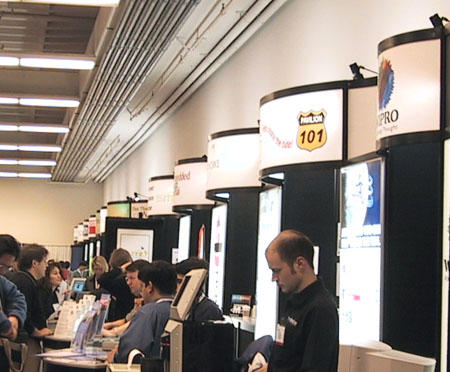
Lineo's RTAI software radio earns my “geekiest ESC demo” award.
For full details on how you can replicate this experiment, see this LinuxDevices.com HOWTO article: www.linuxdevices.com/articles/AT3239582376.html.
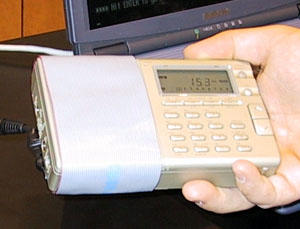
Agenda's VR3: The “World's first Pure Linux PDA” was showcased in the Tux Theater of the ELC's Pavilion 101. It's based on an NEC VR4181.
The Intel Pro/DSL 4200 Home Gateway, shown in Red Hat's booth, is based on (surprise!) an Intel SA-110 StrongARM processor and runs Red Hat's 2.4 kernel along with RedBoot.
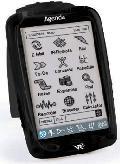
A yet-to-be-announced Korean cell phone/PDA
Shown by PalmPalm is the size of a real cell phone. PalmPalm couldn't disclose any details about the device due to being under nondisclosure with its manufacturer.
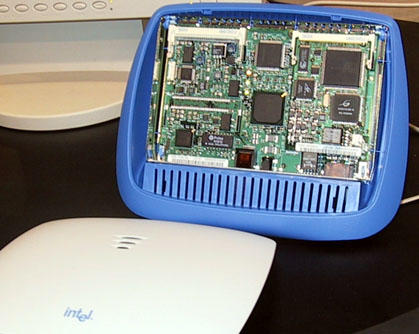
The SK Telecom PDA/cell phone
Shown y PalmPalm, is a combination PDA and cell phone that has received quite a bit of publicity over the last six months.

Ericsson's Bluetooth BLIP
Which functions as a Bluetooth access point and communications gateway, made a guest appearance at ESC in Ericsson's booth. Can you believe this tiny device contains a complete Linux system, including Bluetooth connectivity?
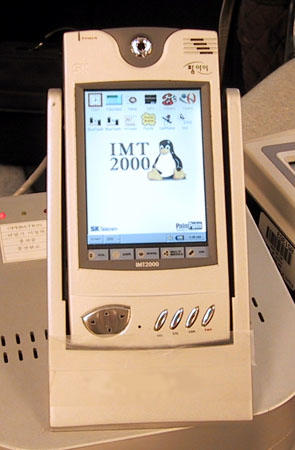
Ericsson's Wireless Webpad
Shown by Trolltech, has received tons of publicity over the last year. As you might guess, it uses Trolltech's Qt along with embedded Linux. The HP10 is guilt around Intel's StrongARM SA-1110 system-on-chip processor equipped with 32MB of DRAM plus 32MB of Flash memory.
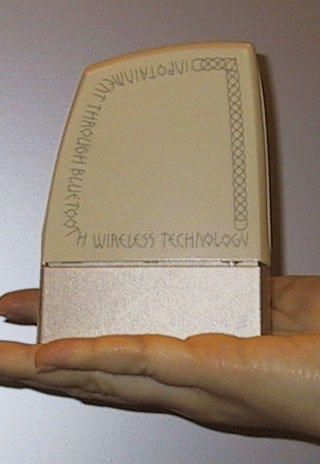
Symbol Technology's wireless PDA
Shown by Red Hat, a handheld computer containing an NEC VR4181 system-on-chip processor, with 16MB RAM and 12MB Flash, and runs uClinux with Century Software's Microwindows and ViewML GUI/windowing software. Red Hat developed the required support for CDPD, GSM, 803.11B wireless connectivity. The device was developed for Sun Microsystems to be used as a handheld field service computer.